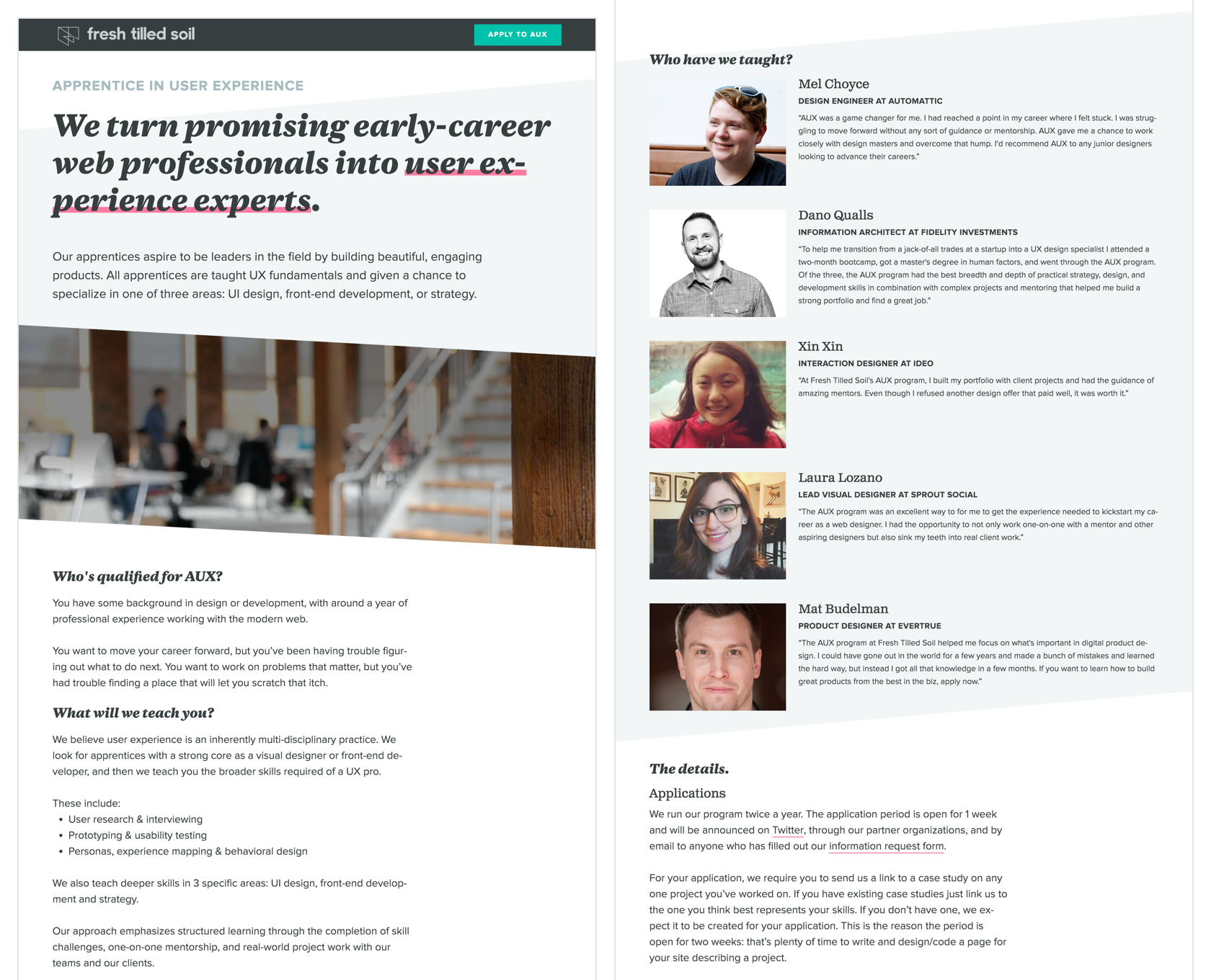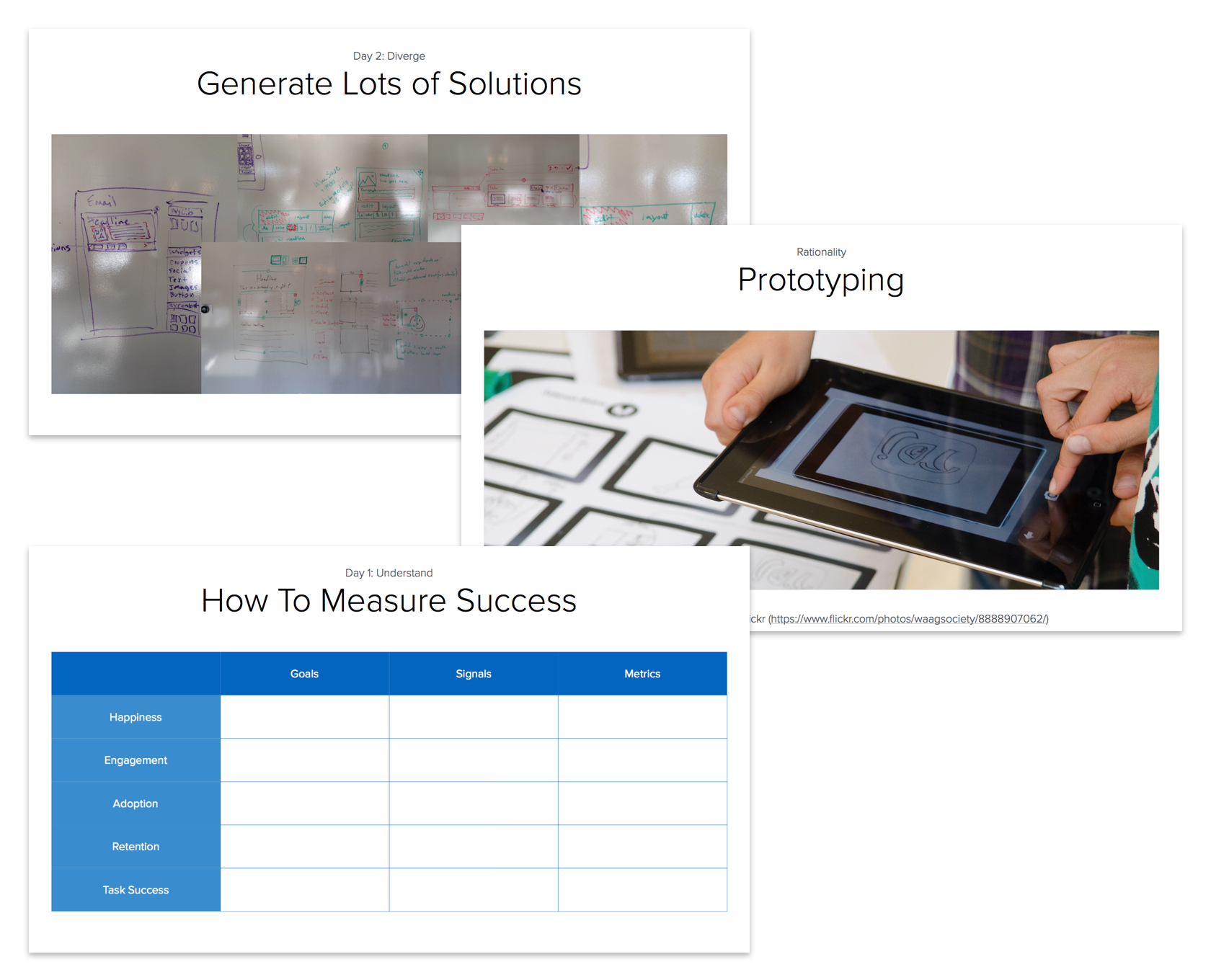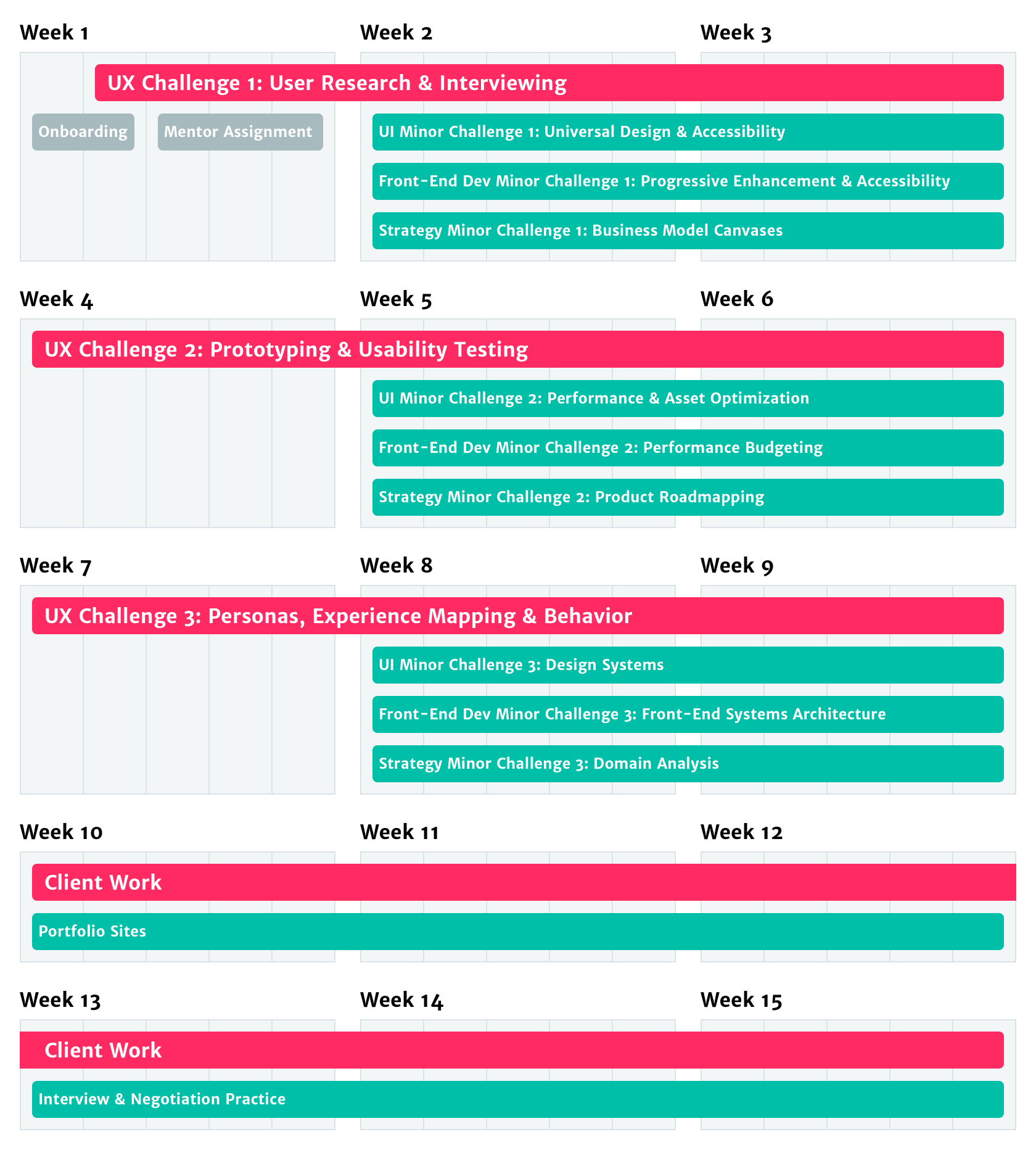
The updated program page I created to kick off our revamped recruiting strategy for version 2. You can view an archive of it here.
In 2012 I joined Fresh Tilled Soil, right after completing a 3 month training apprenticeship at Thoughtbot in Boston. Within my first couple months I was given a new challenge: help to design an apprenticeship of our own. The result was AUX: Apprentice in UX.
Version 1
I worked with Tim Wright (a front-end developer) and Geordie Kaytes (the program’s first apprentice and future UX strategist) to create a curriculum that would equip designers with the skills necessary to work on the modern web.
As anyone who’s worked in tech in the past 10 years knows, the sheer amount of relevant knowledge can be overwhelming even to experts. A solid niche is vital to long-term career development. Our task was to pick the most important information for an apprentice to build the base of their entire career.
Version 1 has been lost to wherever old documents go to die, superceded and overwritten as we improved it. It was not a masterpiece. But it was a solid foundation. Our first class was wonderful, and they graduated with real-world experience after 3 months. Then we had to do it again.
Growing Pains
Version 2 went much the same as the first. We took what we learned from that first curriculum, adapted and improved it, recruited a new cohort and helped them find their way into the industry.
But over the next couple of years it became a lower priority to the company. We slacked on recruitment, didn’t develop the curriculum much, and had less time for our apprentices. The company was doing well and finding industry recognition and gradually AUX slipped to the backburner.
Reboot
In 2014, I couldn’t ignore how the program was slipping any more. We made a huge mistake with an apprentice that could have had a permanent detrimental effect on their career. We ended up extending their term to 6 months to make sure we could help them recover from it. But I didn’t want anyone else to suffer if we screwed up.
I took full ownership of the program with the goal of rebuilding it from the ground up. After going through our old docs and interviewing past apprentices I realized the program had 2 major issues.
Lazy Recruiting
Our recruiting efforts had become so poor that we were accepting any applicant just to make sure we had enough people in a cohort to make it worth running.
Stagnant Curriculum
Our curriculum was lagging behind the industry because there was so much that we could teach that we didn’t cover any particular subject very well.
Problem 1: Fixing Recruiting
“Bootcamp” had been part of AUX from day one. The first few weeks were an “in-over-your-head” project to see how applicants responded. In theory, we would learn if somebody couldn’t take it and cut them from the program. In practice, we never did this. People quit jobs to come work for us for 3 months. Kicking them out could have had terrible consequences in their personal lives.
Selection
I ended up rewriting this part of the program into two weekend workshops and a project to be evaluated. The first weekend was a workshop on how to run a design sprint. Then I assigned applicants a subject, gave them a few hours to work together on brainstorming and ideation, and sent them off on their own. Over the following week I expected them to do about 2 hours a day of work, and then put together a 10 minute presentation to share the following weekend. From these presentations I’d choose 4 or 5 people to enter the program.
This gave us the chance to be critical and selective. Nobody had to quit their job to participate. And they’d learn something worthwhile from the process. We’d be able to evaluate them working as a group on the first weekend, and presenting and taking feedback on the second weekend. All this gave us enough information to be making good decisions with when selecting people to invite to the full program.

These are some slides from the bootcamp workshop. You can view the full presentation here.
Volume
The other major change I made to was designed to increase the volume of applicants. First, applications were accepted for only a short period of time instead of on a rolling basis to make sure applicants would be available if picked. Then, I made connections with groups reprenting designers from diverse and underepresented communities in tech. When recruiting time came around I coordinated with them to reach all their community members.
Results
In the past, the program had never received more than 10 applicants per session, and usually only 4-5. Our first session with the new system got 60. By the final session before I left the company we got 200. We invited the 30 best applicants to bootcamp and then we picked the best 4-5.
We had our best 4 cohorts of apprentices in the two year period we ran the program like this. We already understood their talents, they could work as a group, and the diversity of our applicants and finalists was reflective of the demographic makeup of the Boston metro area as a whole.
Problem 2: Improving the Curriculum
My second change was a complete overhaul of the curriculum. Our first version had been a little too scattered. There was a lot going on in UX, we weren’t committed to what was important and what wasn’t, and we tried to teach it all. A lot changed in those two years. I realized we’d be better off teaching a core set of principles that students could build on, and being really opinionated about what that core was. As a company we had to decide what we thought UX was.
An Opinionated Stance
I decided that anyone invited to bootcamp would have to have basic visual design skills already so that we didn’t have to focus too hard there. That decision freed us up to teach the things that we thought made UX design different than other design disciplines.
This came down to 3 core areas:
- User Research and Interviewing
- Personas, Experience Mapping and Behavior
- Prototyping and Usability Testing
More Working Time
I also increased the timeline of the apprenticeship from 12 to 15 weeks. Each major skill area was taught through a challenge spread out over 3 weeks. The last 6 weeks were spent on actual client work. I also introduced the idea of “minoring” into the program. Every apprentice learned the core skills and also worked on additional, smaller challenges in the areas of either UI design (Challenges 1, 2 and 3), front-end development (Challenges 1, 2 and 3) or strategy (Challenges 1, 2 and 3). Every major challenge had a related minor challenge in these areas. During the client work phase these were replaced with sessions to work on portfolio sites and practice for interviews and salary negotations.

A diagram of the updated program structure I created.
Results
The new curriculum was a massive improvement and allowed us to graduate apprentices that we felt had a powerful, differentiated skillset in the job market. By preparing them for interviews and job hunting we were also helping to guarantee their success and improve the reputation of our program. To this day I still consider what I defined in the curriculum to be the core skills of a great UX designer.
Additional Benefits
Aside from the immediate and visible improvements in the program itself, my changes had a measureable effect on the company. In enlisting other employees to help me define and write curriculum, teach workshops, and mentor apprentices I was able to make our own employees better at their jobs. Teaching has a way of forcing people to evaluate how they understand a subject and improve their own skills.
I also accidentally made the program profitable by increasing the time spent on client work and building it into the schedule in advance. Business development and project management were able to plan around having additional people on projects and charge accordingly. This made it so that management was committed to giving me part of my schedule to run the program and let me keep improving it.
Final Thoughts
Building, rebuilding and leading this program was one of the most challenging experiences of my career, and is definitely the most rewarding so far. Seeing the difference we were able to make in the careers of the people we taught convinced me that I want mentoring and leadership to continue to be a huge part of my professional development.